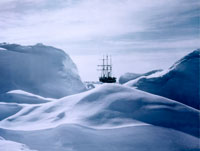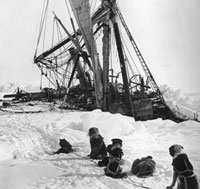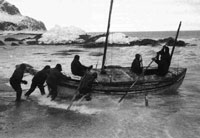In 1914, a British explorer named Ernest Shackleton led an unsuccessful attempt to cross Antarctica, where his 27-man crew became stranded for 20 months. This incredible story is one of relentless drive and perseverance in the face of overwhelming odds, and of one man’s extraordinary leadership skills and unmatched discipline.
Early Expeditions
From an early age, Ernest Shackleton had a strong desire for adventure and exploration. He was fascinated with exploring the South Pole, and enjoyed reading books about exploring. From his memoir, titled South, Shackleton wrote, ‚ÄúI seemed to vow myself that some day I would go to the region of ice and snow and go on and on till I came to one of the poles of the earth, the end of the axis upon which this great round ball turns.‚ÄĚ
After Shackleton finished school, he joined the Merchant Marines. His first expedition was the National Antarctic Expedition, organized by the Royal Geographic Society and led by explorer Robert Falcon Scott in 1902. Setting sail in the ship Discovery, Shackleton took off with Scott and Edward Wilson toward the South Pole. The explorers were all inexperienced and ran into a number of obstacles.
Still hundreds of miles from their destination, and short on food, Scott made the decision to turn back while they still had a chance to survive. On the return trip, Shackleton came down with scurvy. Upon meeting up with another team, Scott sent Shackleton back to England to recover.
After a number of years in England, Shackleton married and began to focus on building a family. But again, the South Pole was on his mind. He soon began preparations for a second Antarctic journey.
In 1907, Shackleton organized and led the British Antarctic Expedition, also called the Nimrod Expedition, named after the ship. This expedition brought them just less than 100 miles from their goal of the South Pole. Although not completely successful, the crew became the first to climb Mount Erebus (an active volcano), discover the location of the magnetic South Pole, and locate the Beardmore Glacier passage. It was also the first time anyone had crossed the Transantarctic Mountains to reach the Antarctic Plateau.
After returning, Ernest Shackleton was welcomed as a hero and immediately knighted. For the next three years, he enjoyed fame and success as ‚Äúthe man who reached the furthest to the south.‚ÄĚ
The Endurance
After tasting success, Shackleton began to plan another expedition. He organized what would be the first team to cross the Antarctic continent‚ÄĒa 1,800-mile journey across the unknown. During the trip, team members also planned to make magnetic observations and study ice formations and mountains.

Trapped in Ice: Endurance, the ship Ernest Shackleton and his crew traveled on, is trapped in Antarctic ice.
Photo: Frank Hurley/State Library of New South Wales
The expedition was called the Imperial Trans-Antarctic Expedition and was led by Shackleton. He named his ship the Endurance, which was inspired by his family‚Äôs motto, ‚ÄúBy endurance we conquer.‚ÄĚ
After preparations were complete, the team was eager to embark. Everything was in order. But just as Shackleton and the crew were about to set sail, World War I broke out between Britain and Germany. Showing tremendous loyalty to his country, Shackleton questioned whether the expedition was still worthwhile.
Shackleton sent a telegram to the Admiralty (the group in charge of the Royal Navy) and explained to his crew, ‚ÄúFirst let me say that if war is declared, any man who wishes to leave the expedition to serve his country is free to do so. It is clear to me where our first duty lies, and this morning I telegraphed the First Lord of the Admiralty and put our ship, and every one of us, at his disposal. We now await his decision. I hope you will forgive me, but I particularly asked that if he saw fit to employ us in the service of our country, that might he allow us to stay together, perhaps aboard a destroyer. I did this because I can honestly think of no finer group of men with whom to serve.‚ÄĚ
Shackleton received a one-word reply: ‚ÄúProceed.‚ÄĚ
The Endurance set sail on August 9, 1914.
Early Trouble
After sliding through clear, open water for a time, the Endurance was confronted with unexpected amounts of pack ice. Shackleton stayed awake through the night and navigated the dangerous ice as it scraped the sides of the ship. By morning, the Endurance had pushed through the ice and into open water.
Shackleton described this time: ‚ÄúThis initial tussle with the pack [ice] had been exciting at times. Pieces of ice and bergs of all sizes were heaving and jostling against each other‚ĶIn spite of all our care the Endurance struck large lumps stem on, but the engines were stopped in time and no harm was done.‚ÄĚ
The first few hundred miles were rough, but the ship made it successfully through the ice. After continuing, the Antarctic summer soon ended and the winter months set in. The ship began to run into heavier ice.
‚ÄúThe sun sank lower in the sky, the temperatures became lower, and the Endurance felt the grip of the icy hand of winter. Two north-easterly gales in the early part of April assisted to consolidate the pack. The young ice was thickening rapidly, and though leads were visible occasionally from the ship, no opening of a considerable size appeared in our neighborhood.‚ÄĚ
Shackleton soon realized they were stranded. Cracks in the ice appeared, but, in the end, attempts to free the ship were unsuccessful. The crew prepared for the long, cold winter, and turned the ship into a winter station. The men determined to wait out the winter in hopes that the coming spring would melt the ice around the ship and free it.
Waiting It Out
Shackleton remained optimistic and, despite the circumstances, the explorers stayed cheerful and busy. They cut out large blocks of ice and built igloos around the ship for themselves and the dogs. They survived on rations and seals that came within reach of their temporary camp. Temperatures were frigid, sometimes dipping down to less than minus 20 degrees Fahrenheit. But with dogsled races, and frequent games of hockey and football, they kept their spirits high.
As the months went by, the ship drifted in the ice, but was still trapped. Shackleton wrote in his July 26, 1915 journal entry, ‚ÄúThe ice for miles around is much looser. There are numerous cracks‚ĶRidges are being forced up in all directions‚ĶIt would be a relief to be able to make some effort on our own behalf; but we can do nothing until the ice releases our ship.‚ÄĚ
It was now September. As the pressure around the ship threatened to crush it, the crew prepared for the worst.
Shackleton wrote: ‚ÄúI scarcely dared hope now that the Endurance would live, and‚ĶI reviewed again the plans made long before for the sledging journey that we must make in the event of our having to take to the ice. We were ready, as far as forethought could make us, for every contingency. Stores, dogs, sledges, and equipment were ready to be moved from the ship at a moment‚Äôs notice.‚ÄĚ
Taking to the Ice
Shackleton’s fears came true as the ice slowly closed in on the ship. The team could do nothing but watch as what seemed like their only hope of survival vanished.

Crushed: After over a year of being trapped in the ice, the wreckage of the Endurance sinks into the freezing water (Nov. 1915).
Photo: Royal Geographic Society
Yet as the ice slowly crushed the ship, Shackleton remained optimistic. He refused to give up, making plans to press forward. Encouraging the men, he thanked them for ‚Äúthe steadiness and good morale they have shown in these trying circumstances.‚ÄĚ He told them that he had ‚Äúno doubt that, provided they continued to work their utmost and to trust‚ÄĚ him, they would ‚Äúall reach safety in the end.‚ÄĚ
They began to make preparations for a journey to Paulet Island. Although the island was more than 300 miles away, it was the closest place with any possibility of finding food and shelter. Shackleton recalled that there was a small hut there filled with supplies from a previous Swedish expedition.
In order to keep weight at a minimum, each man was allowed to take no more than 2 pounds of equipment with him. Dogs helped tow two lifeboats, each weighing around a ton.
Through blizzards and thick snow, the men pressed on. After traveling a number of miles, they set up ‚ÄúOcean Camp,‚ÄĚ where they rested for two months.
Changing Course
In the beginning of 1916, the team was still 250 miles from Paulet Island and too far east of it. Shackleton wrote: ‚ÄúAfter a year‚Äôs incessant battle with the ice, we had returned‚Ķto almost identically the same latitude that we had left with such high hopes and aspirations twelve months previously; but under what different conditions now! Our ship crushed and lost, and we ourselves drifting on a piece of ice at the mercy of the winds.‚ÄĚ
The men packed up camp and continued north. After marching for several days, they set up another camp to rest for the next leg of the journey. By March, Shackleton realized there was little hope of reaching Paulet Island, due to the difficulty of sledging across broken sea ice. They next considered Elephant Island, just 100 miles straight north.
As they traveled through the bitter cold and blizzards, Shackleton had to carefully ration food. Anytime a seal or penguin came within vicinity of the men, it was quickly killed for food and fuel. The captain wrote: ‚ÄúI have stopped issuing sugar now, and our meals consist of seal-meat and blubber only, with 7 oz. of dried milk per day for the party‚ĶEach man receives a pinch of salt, and the milk is boiled up to make hot drinks for all hands. The diet suits us, since we cannot get much exercise on the floe‚ĶFried slices of blubber seem to our taste to resemble crisp bacon.‚ÄĚ
The crew now set their sights on the more realistic goal of reaching Elephant Island. Upon finally reaching the island, Shackleton decided to give the men a few days rest and recuperation. They had only enough full rations to last another five weeks. The journey was beginning to take its toll on them. Most were exhausted, underfed and in poor mental condition after the long months of travel.
South Georgia
Shackleton knew the only hope for survival was if a few men journeyed to find a rescue ship. Shackleton wrote, ‚ÄúA boat journey in search of relief was necessary and must not be delayed.‚ÄĚ He discussed with a few of his top men the prospect of making it to South Georgia before another winter approached; the decision was soon made. The plan was to cross the more than 800 miles of Southern Ocean to the possibility of help at South Georgia.

On a Mission: Shackleton and a few of his crew members launch a lifeboat from Elephant Island to begin an arduous 800-mile voyage to South Georgia (April 24, 1916).
Photo: Frank Hurley
After preparing the boat, Shackleton and five others set sail from Elephant Island. The voyage was one of constant discomfort and narrow quarters. Shackleton recalled, ‚ÄúWe fought the seas and the winds and at the same time had a daily struggle to keep ourselves alive. At times we were in dire peril.‚ÄĚ
Days went by and Elephant Island gradually shrank into the distance.
The men pushed on through the driving winds and ferocious waters of the frigid sea. The explorers finally landed on the southern coast of South Georgia. But the whaling station was on the opposite side of the island.
Shackleton recounted this time: ‚ÄúWe were still 150 miles away from Stromness whaling-station by sea. The alternative was to attempt the crossing of the island‚ĶOver on Elephant Island twenty-two men were waiting for the relief that we alone could secure for them. Their plight was worse than ours. We must push on somehow.‚ÄĚ
Rescue!
They soon made plans to cross over the mountain range to the other side of the island. The men removed screws from the boat to use in their boots for traction to climb the treacherous ice slopes. They crossed the island to the whaling station after more than a day’s journey.
After descending the mountains, they heard the distinct sound of a steam-whistle. Shackleton wrote, ‚ÄúNever had any one of us heard sweeter music. It was the first sound created by outside human agency that had come to our ears since we left‚ĶThat whistle told us that men were living near, that ships were ready, and that within a few hours we should be on our way back to Elephant Island to the rescue of the men waiting there‚ĶIt was a moment hard to describe. Pain and ache, boat journeys, marches, hunger and fatigue seemed to belong to the limbo of forgotten things, and there remained only the perfect contentment that comes of work accomplished.‚ÄĚ
The whalers sent a ship to the other side of the island to pick up the remaining men there, then continued on to rescue the 22 others on Elephant Island.
In the end, the expedition lasted two years. All 27 of the men survived! When one of the survivors was asked how they had made it, he answered with one word: ‚ÄúShackleton.‚ÄĚ
‚ÄúEndure unto the End‚ÄĚ
What lessons can we learn from this incredible story of survival? Shackleton’s example of extraordinary leadership and perseverance has many applications for those striving to live God’s Way.
Those growing up in God’s Church face an extremely difficult age, bombarded every day at school, work or home by the pulls of this world. You may feel intense pressure to give in to the ways of this world. But if you are striving to please God, you must not give in.
Although Proverbs 13:15 states that ‚Äúthe way of transgressors is hard,‚ÄĚ living according to God‚Äôs laws and principles is not easy either. Overcoming this world is hard work, and takes longsuffering, patience and endurance. Yet it is possible, and yields incredible blessings if one stays the course and refuses to give in‚ÄĒno matter the cost.
Those living God‚Äôs Way must endure trials. They must overcome many obstacles in their lives. Notice Matthew 24: ‚ÄúBut he that shall endure unto the end, the same shall be saved‚ÄĚ (vs. 13). Here, endurance is directly tied to receiving salvation. (Also see Mark 4:17 and James 5:11.) The Greek word for endure means to ‚Äúremain‚Ķbear (trials)‚Ķhave fortitude‚Ķpersevere, abide, take patiently, suffer.‚ÄĚ
Endurance is a godly characteristic of which we should all strive to have more. In fact, God never quits. And once we have decided to live His Way, neither can we. We must stay the course! When you feel like caving in, or giving up, consider Shackleton’s story and how he overcame against all odds.
If we persevere, God promises our reward will be great (Rev. 21:7)!



















